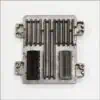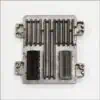Restore Your Yukon’s Performance and Peace of Mind
Is your GMC Yukon running rough, hesitating, or throwing confusing check engine lights? A failing Engine Control Module (ECM) can feel like a mysterious, frustrating problem, turning your dependable truck into a source of daily stress. This isn’t just an inconvenience; it’s a matter of reliability and safety. This module is the solution, acting as the restored central command for your engine. It arrives fully programmed to your vehicle’s specific VIN with the latest GM software updates, eliminating guesswork and costly dealership visits. Regain the smooth acceleration, consistent fuel economy, and unwavering confidence you expect from your vehicle. It’s time to solve the problem at its source and get back to driving, not diagnosing.
Signs Your Engine’s Brain Needs Help
If you’re noticing any of the following symptoms, a faulty ECM is a likely culprit. Replacing it can resolve these issues and prevent further damage to related components.
- ✔ Persistent Check Engine Light: Especially for codes like P0601, P0602, P0606, or other internal processor faults.
- ✔ Rough or Unstable Idling: The engine struggles to maintain a consistent RPM at a stop.
- ✔ Sudden Stalling or Misfires: Unpredictable engine shutdowns or stumbling during acceleration.
- ✔ Reduced Fuel Economy: Your truck is suddenly thirstier than usual without a change in driving habits.
- ✔ Erratic Transmission Behavior: Harsh shifting or failure to shift gears properly can often be traced back to poor communication from the ECM.
- ✔ Complete No-Start Condition: The engine cranks but refuses to start, even with a good battery and fuel supply.
Guided Installation to Restore Peak Performance
Installing your new 2008 Yukon Engine Module is a straightforward process that you can tackle with basic hand tools. Follow these steps for a confident, successful repair.
- Safety First: Always begin by disconnecting the negative terminal from your vehicle’s battery to prevent any electrical shorts.
- Locate the Old Module: On most 2008 GM trucks and SUVs like the Yukon, the ECM is located in the engine bay, on the driver’s side, often under or near the battery tray.
- Disconnect Wiring Harnesses: Carefully release the locking tabs on the electrical connectors and pull them straight out from the module. Avoid pulling on the wires themselves. There are typically two or three large connectors.
- Remove Mounting Bolts: Use a socket wrench to unbolt the old module from its mounting bracket. Keep the hardware in a safe place.
- Install the New Module: Seat your new, pre-programmed ECM onto the mounting bracket and secure it with the original bolts.
- Reconnect Harnesses: Firmly plug the wiring harnesses back into the new module. You should hear or feel a click as they lock into place.
- Reconnect Battery: Re-attach the negative battery terminal and tighten it securely.
- Perform Security Relearn: In many cases, you will need to perform a simple key-cycle security relearn procedure. This typically involves turning the key to the ‘ON’ position for 10-15 minutes, then off, and repeating two more times. This allows your vehicle’s anti-theft system to recognize the new module.
A Mechanic’s Note: The End of the Diagnostic Chase
“I once had a customer with a 2008 Sierra who had spent nearly a thousand dollars chasing a ghost. He’d replaced O2 sensors, the mass airflow sensor, and even a fuel injector trying to fix a persistent rough idle and poor mileage. His scanner gave him conflicting codes. Finally, he brought it to my shop. After checking the basics, I suspected the ECM. We installed a VIN-programmed 2008 Yukon Engine Module (the same E38 series module), and it was like a new truck. All the phantom issues vanished. Sometimes, the problem isn’t the soldiers; it’s the general giving the orders.”
– 20-Year Master Technician
Tailored Fit for Your GM Vehicle
This module is a direct-fit replacement, guaranteed to be compatible with a wide range of GM models. Please verify your vehicle is on the list below. This unit is a direct replacement for part numbers 12612384, 12622141, and 12617568.
- AVALANCHE 1500 (2008)
- AURA (2008) – 3.5L
- CAPRICE (2011) – ID 12612384
- CORVETTE (2008-2009)
- CTS (2008) – 3.6L, VIN 7
- EQUINOX (2008-2009) – 3.4L
- ESCALADE / ESV / EXT (2008)
- EXPRESS / SAVANA VANS (2008) – Gasoline Engines
- G6 (2008) – 3.5L, 3.9L
- HUMMER H2 (2008)
- IMPALA (2008) – 3.5L, 3.9L
- MALIBU (2008) – 3.5L (Classic & New Style)
- SIERRA / SILVERADO 1500, 2500, 3500 (2008)
- SUBURBAN 1500 / 2500 (2008)
- TAHOE (2008) – w/o hybrid
- TORRENT (2008-2009) – 3.4L
- VUE (2008-2009) – 3.5L
- YUKON / YUKON XL 1500 / XL 2500 (2008) – w/o hybrid
Frequently Asked Questions
Does this module require additional programming?
No. We program the module with the latest GM updates using the VIN you provide during checkout. It arrives ready for installation, though a simple security relearn procedure may be necessary, which does not require any special tools.
How do I find my vehicle’s VIN?
Your 17-digit Vehicle Identification Number (VIN) can be found on your vehicle’s registration, insurance card, or on a small plate on the driver’s side of the dashboard, visible through the windshield.
Will this fix my specific check engine light codes?
This 2008 Yukon Engine Module is the definitive solution for internal processor failure codes (like P0601-P0606) and often resolves a wide range of communication or sensor-related codes that stem from a faulty main computer. However, always ensure other components have been checked for proper function.
Is this a difficult part to install myself?
For most DIYers with basic tools, this is a very manageable job. The module is typically easy to access, and the process involves unplugging connectors and removing a few bolts. Our installation guide above provides a clear overview of the steps.
What happens if I don’t provide my VIN?
Providing your VIN is essential. We cannot ship the module until we receive your VIN, as the programming is specific to your vehicle’s factory options, engine, and transmission. This ensures a perfect, plug-and-play fit.


